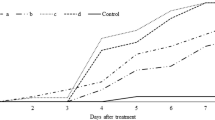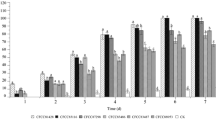Abstract
Laboratory bioassay of the two fungiMetarbizium anisopliae (Metschnikoff) Sorokin andVerticillium indicum (Petch) Gams was carried out under 26±1 C° and 75±2% R. H. This is the first study on the efficiency of both mycopathogens against the termiteCryptotermes brevis (Walker). Using the highest concentration ofM. anisopliae (43.5 × 105 V.S/ml), percentages of mortality after 4 weeks from treatment of the termiteC. brevis fed on filter paper or wood were 100 and 93.33, respectively. On the same time, the highest concentration of the fungiV. indicum (34.3 × 105 V.S/ml) resulted in the mortality percentages of 83.33 and 70, respectively, fed on filter paper and wood. In general, the data indicated more susceptibility of the termiteC. brevis to the entomopathogenic fungusM. anisopliae than to the fungusV. indicum. M. anisopliae could be considered as a promising potential mycopathogen against the termiteC. brevis. This study, presenting new approach of the alternative dry wood termite control, might be applied in the future.
Similar content being viewed by others
References
Abbott, W. S., 1925: A method of computing the effectiveness of insecticides. J. Econ. Ent.18, 256–67.
Bao, L. L.;Yendol, W. G., 1971: Infection of the eastern subterranean termite,Reticulitermes flavipes (Kdlar) with the fungusBeauveria bassiana (Balsomo) Wuill. Entomophaga16, 343–352.
Blackweel, M.;Rossi, W., 1986: Biogeography of fungal ectoparasites of termites. Mycotaxon25, 581–601.
Cheung, P. Y. K.; Grula, E. A., 1980: Alteration of haemolymph components in corn earworm larvae by the entomopathogenBeauveria bassiana. Abstr. Annu. Meet., Am. Soc. Microbial 80.
Franz, J. M., Krieg, A., 1982: Biologische Schädlingsbekämpfung unter Berücksichtigung integrierter Verfahren. 3. Aufl. Pareys Studientexte 12, P. Parey, Berlin, Hamburg, (C. F. comprehensive insect physiology, biochemistry and pharmacology, Pergamon Press. Oxford. Chapter 129: Fungal Control, 1983)
Gabriel, B. P., 1968: Enzymic activities of some entomophthorous fungi. J. Invertebr. Pathol.11, 70–81.
Gardner, W. A., Suton, R. M., Noblet, R., 1979: Effect of infection byBeauveria bassiana on haemolymph proteins of noctuid larvae. Ann. Ent. Soc. Amer.72, 224–228.
Grace, J. K., 1991: Termite-fungi associations and manipulations for termite control. Soc. for invertebrate pathology northern Arizona. University. Prog. and Abstr. XXIV Ann. Meeting, p. 29.
Grace, J. K., 1993: Microbial termite control effects of entomogenous fungi on the formosan subterranean termite (Isoptera; Rhinotermitidae). Proc. of the 1st Intern. Conf. on insect pest in the urban environment. Cambridge, U.K.P., 474.
Hafez, M., 1980: Highlights of termite problem in Egypt. Sociobiol.5, (2), 147–153.
Hall, R. A., 1982: Control of aphids by fungus,Verticillium lecanii: Effect of spore concentration. Entom. expert. et appli.27, 1–5.
Hall, R. A., 1982: Control of whitefly.Trialeurodes vaporariorum and cotton aphidAphis gossypii in glass houses by two isolates of the fungesVerticillium lecanii. Ann. Appl. Biol., 101, 1–11.
Ignoffo, C. M., 1981: The fungusNomuraea rileyi as a microbial insecticide. In microbial control of pests and diseases. 1970–1980, pp. 513–538, Ed. H. D. Burges, Acad. Press, London.
Khan, K., 1991: Mycopathogens for biological control ofOdontotermes brunneus (Hagen). J. Biol. cont.5 (1), 32–35.
Kiraly, Z.;Klement, Z.;Sobymosy, F.;Voros, J., 1970: Methods in plant pathology-with special reference to breeding for disease resistance. Akad. Kiado, Budapest.
Kodaira, Y., 1961: Biochemical studies on the muscardine fungi in the silkworms,Bombyx mori. J. Fac. Textile Sericult., Shinshu Univ., Ser. E.5, 1–68.
Kucera, M., 1980: Proteases from the fungusMetarbizium anisopliae toxic forGalleria mellonella larvae. J. Invert. Pat.35, 304–310.
Lay, P. Y.;Tamashiro, M.;Fuju, J. K., 1982: Pathogenicity of six strains of entomogenous fungi toCoptotermes formosanus. J. Invert. Path.39, 1–5.
Litchfield, J. T.;Wilcoxon, F., 1949: A simplified method of evaluating dose-effect experiments. J. Pharm. and Exp. Therap.96, 99–133.
McCoy, C. W., 1974: Fungal pathogens and their use in the microbial control of insects and mites. Mississippi Univ. Press, Jackson. 504–575.
McMahan, E. A., 1969: Studies of termite woodfeeding preferences. Proc. Hawaiian Ent. Soc.19, 239–250.
Moore, B. P., 1969: Biochemical studies in termites. In “Biology of termites” (K. Krishna and F. M. Weesner, eds.), vol. 1. Acad. Press, New York.
Roberts, D. W.;Yendol, W. G., 1971: Use of fungi for microbial control of insects. In “Microbial control of insects and mites” (H. D. Burges and N. W. Hussey, eds.) Acad. Press. New York.
Samsináková, A.;Kalalova, S., 1976: Mass cultivation of entomophagous fungusVerticillium lecanii. Ceska Mykol.30, 118–20.
Sands, W. A., 1969: The association of termites and fungi. In Krishna, K. & Weesner, F. M. (Eds) Biology of termites, London, Acad. Press,1, 495–524.
Smythe, R. V.;Coppel, H. C., 1966: Pathogenicity of externally occurring fungi toReticulitermes flavipes. J. of Invert. Path.8, 266–267.
Stuart, A. M., 1969: Social behavior and communication. In “Biology of termites” (K. Krishna and F. M. Weesner, eds.) vol. 1. Acad. Press, New York.
Surany, P., 1960: Diseases and biological control in rhinoceros beetles. S. Pacific Comm. Tech. Paper No.128, Vi+61 pp.
Suzuki, K., 1991: Laboratory trial of biological control agents against subterranean termites. The International Res. Group on wood preservation. IRG/WP/1475. The 22nd ann. meeting Kyoto, Japan, 1–11.
Toumanoff, C., 1965: Action de divers champignons entomophages surReticulitermes santonensis. Ann. Para.40, 611–626.
Toumanoff, C.;Rombaut, J., 1965: Actions de certains champignons entomophage cultives sur les milieux appropries attractifs, sur le termite de SaintongeReticulitermes santonensis. Ann. Paras.40, 605–609.
Watson, J. A. L., 1990: Biological control of termites in Australia Soc. Insect and Environment. Proc. of the 11 th Int. Congr.-IUSSI, India (G. K. Veersh, B. Mallik and C. A. Viralatamath eds.) pp. 632–633.
Wilson, E. O., 1971: The insect societies. Harvard Univ. Press (Belkeney), Cambridge, Mass.
Zimmermann, G., 1993: The entomopathogenic fungusMetarbizium anisopliae and its potential as a biocontrol agent. Pest. Sci.37, 375–379.
Author information
Authors and Affiliations
Rights and permissions
About this article
Cite this article
Nasr, F.N., Moein, S.I.M. New trend of the use ofmetarhizium anisopliae (metschnikoff) sokorin andverticillium indicum (petch) gams as entomopathogens to the termiteCryptotermes brevis (Walker) (Isoptera, Kalotermitidae). Anz. Schadlingskde., Pflanzenschutz, Umweltschutz 70, 13–16 (1997). https://doi.org/10.1007/BF02009610
Issue Date:
DOI: https://doi.org/10.1007/BF02009610




